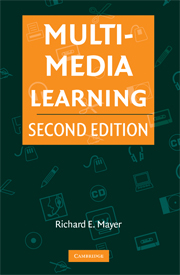Book contents
- Frontmatter
- Contents
- PREFACE
- SECTION I INTRODUCTION TO MULTIMEDIA LEARNING
- SECTION II PRINCIPLES FOR REDUCING EXTRANEOUS PROCESSING IN MULTIMEDIA LEARNING
- SECTION III Principles for Managing Essential Processing in Multimedia Learning
- SECTION IV PRINCIPLES FOR FOSTERING GENERATIVE PROCESSING IN MULTIMEDIA LEARNING
- SECTION V CONCLUSION
- REFERENCES
- AUTHOR INDEX
- SUBJECT INDEX
SECTION III - Principles for Managing Essential Processing in Multimedia Learning
- Frontmatter
- Contents
- PREFACE
- SECTION I INTRODUCTION TO MULTIMEDIA LEARNING
- SECTION II PRINCIPLES FOR REDUCING EXTRANEOUS PROCESSING IN MULTIMEDIA LEARNING
- SECTION III Principles for Managing Essential Processing in Multimedia Learning
- SECTION IV PRINCIPLES FOR FOSTERING GENERATIVE PROCESSING IN MULTIMEDIA LEARNING
- SECTION V CONCLUSION
- REFERENCES
- AUTHOR INDEX
- SUBJECT INDEX
Summary
Consider the following situation. You are interested in how the human digestive system works, so you go to an online encyclopedia and click on a movie icon labeled “How Digestion Works.” You watch a series of eighteen slides, each appearing for about ten seconds and each containing a line drawing on the right and one or two sentences on the left. The lesson feels too fast-paced to you, because as soon as you finish your initial reading of one slide, the next one begins. As a result you don't have time to compare the sentences to the line drawing, or to draw causal connections from one slide to the next. On a subsequent retention test, you can remember parts of some of the sentences, and on a transfer test, you are not able to apply what was presented to solving new problems.
What is essential processing overload? This situation is an example of essential processing overload – that is, a situation in which the cognitive processing of the basic material in the lesson is so demanding that there is little or no remaining cognitive capacity to engage in deeper processing of the material (which I call generative processing). Essential processing overload is likely to happen when the essential material is complex, the learner is inexperienced, and the presentation is fast-paced.
- Type
- Chapter
- Information
- Multimedia Learning , pp. 171 - 174Publisher: Cambridge University PressPrint publication year: 2009



